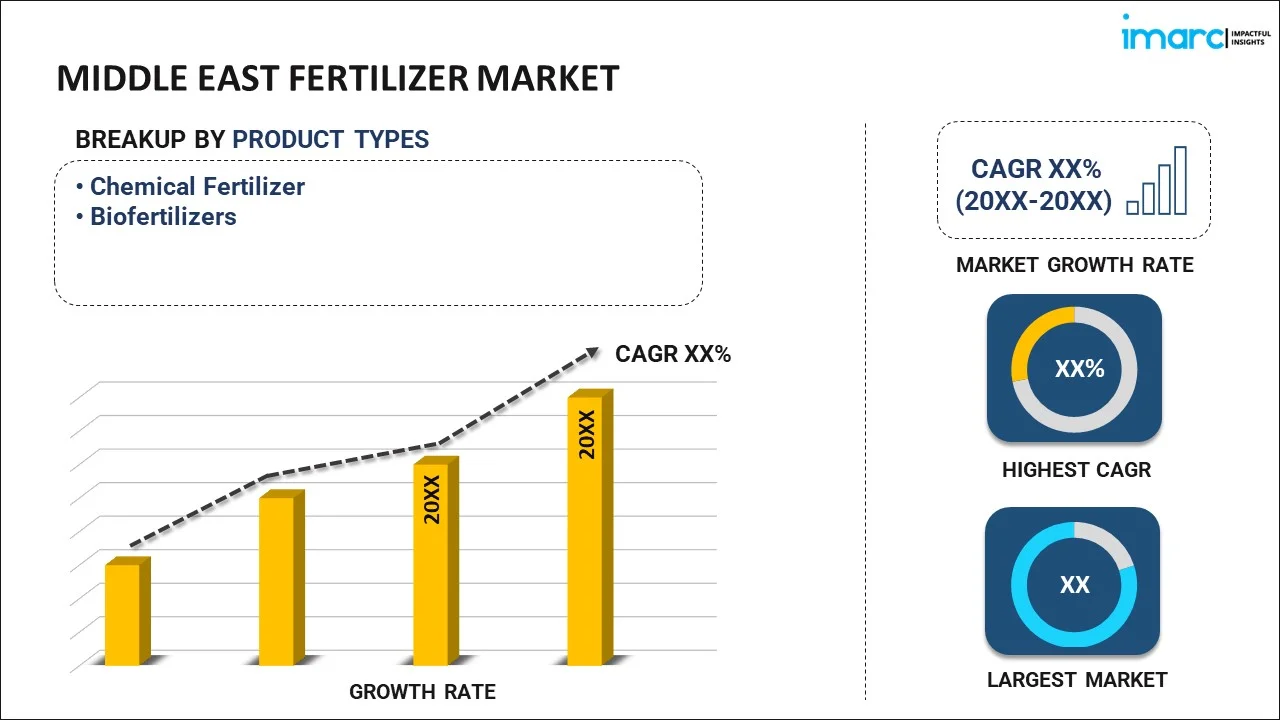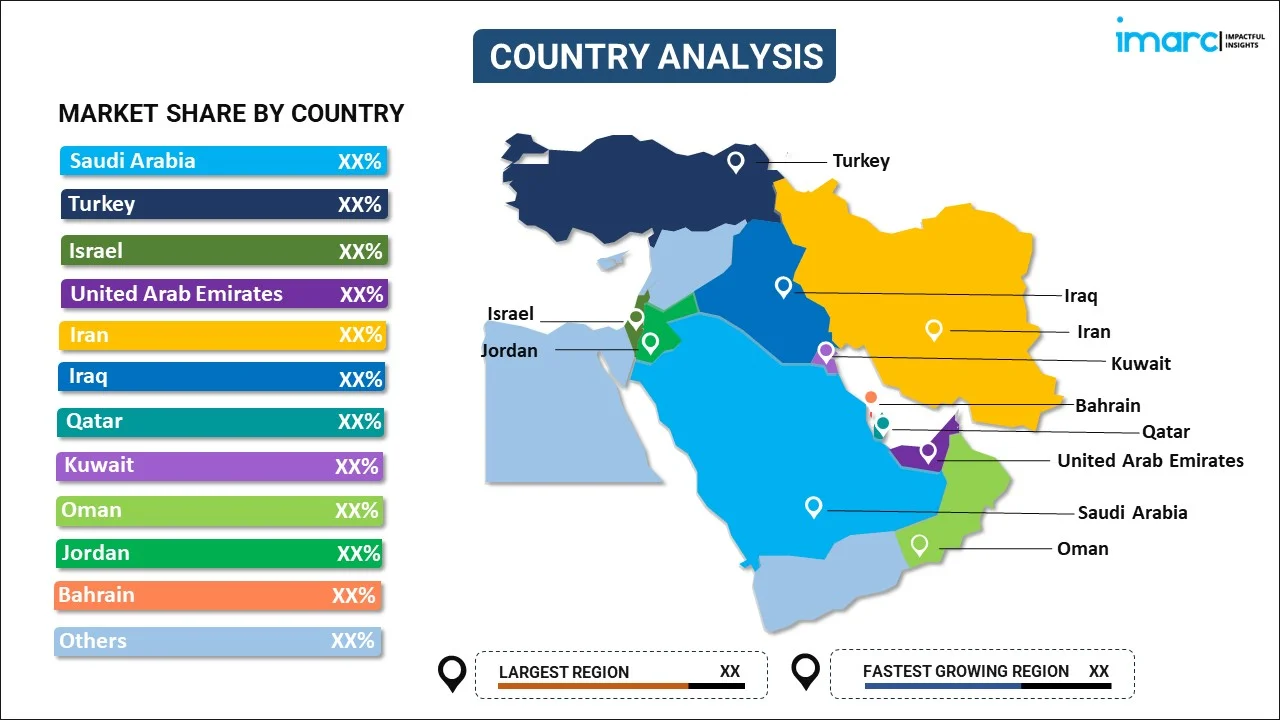
Middle East Fertilizer Market Report by Product Type (Chemical Fertilizer, Biofertilizers), Product (Straight Fertilizers, Complex Fertilizers), Product Form (Dry, Liquid), Crop Type (Grains and Cereals, Pulses and Oilseeds, Fruits and Vegetables, Flowers and Ornamentals, and Others), and Country 2025-2033
Market Overview:
Middle East fertilizer market size is projected to exhibit a growth rate (CAGR) of 6.97% during 2025-2033. The growing consumption of high-quality fruits and vegetables to maintain a balanced diet, increasing research and development (R&D) activities to formulate various effective forms, and rising popularity of precision agriculture represent some of the key factors driving the market.
|
Report Attribute
|
Key Statistics
|
|---|---|
|
Base Year
|
2024 |
|
Forecast Years
|
2025-2033
|
|
Historical Years
|
2019-2024
|
| Market Growth Rate (2025-2033) | 6.97% |
Fertilizer contains essential nutrients and other elements that enhance the fertility of the soil and promote optimal plant growth. It comprises nitrogen-based fertilizers, which include urea and ammonium nitrate, crucial for promoting leafy growth and overall plant development. It also consists of phosphorus-based fertilizers, such as superphosphate and triple superphosphate, which are used for root development and flowering. It encompasses potassium-based fertilizers, which are vital for overall plant health and include potassium chloride and potassium sulfate. It is also manufactured as compound fertilizers, which contain a mix of nitrogen, phosphorus, and potassium in varying ratios, providing a balanced nutrient supply. It is available in dry, grainy powdered form and also in water-soluble formulations, ensuring quick nutrient absorption by plants. Fertilizer contributes significantly to higher crop yields, meeting the demands of the growing population. It also enhances the nutritional content of crops, ensuring better quality and nutritional value. It also improves the disease-resistant capabilities of plants and prevents the occurrence of various complications caused by pathogens. It helps to restore the proper condition of the soil, which is often hampered by continuous farming.
Middle East Fertilizer Market Trends:
At present, the increasing consumption of high-quality fruits and vegetables to maintain a balanced diet and prevent the occurrence of chronic ailments like obesity, diabetes, and arthritis habits represents one of the crucial factors impelling the growth of the market in Middle East. Besides this, the rising focus on maintaining food security is driving the adoption of fertilizers to increase crop yield. In addition, the growing popularity of precision agriculture, which involves the use of technology to optimize field-level management and facilitate precise application of fertilizers based on real-time data, soil analysis, and satellite imagery, is offering a favorable market outlook in the region. The integration of smart farming techniques not only improves the efficiency of fertilizer use but also minimizes environmental impact. Apart from this, concerns about the environmental impact of traditional fertilizer application methods, such as nutrient runoff leading to water pollution and greenhouse gas emissions, are encouraging farmers to focus on sustainable practices. Farmers are also utilizing biofertilizers, which are eco-friendly and minimize nutrient leaching. The promotion of organic farming practices and the development of organic fertilizers are gaining traction, reflecting a broader global commitment to sustainable and eco-friendly agricultural practices. Additionally, the rising research and development (R&D) activities to formulate various effective forms of fertilizers are supporting the market growth. Key market players are also focusing on manufacturing customized fertilizer mixes that are tailored according to the specific requirements of plants.
Middle East Fertilizer Market Segmentation:
IMARC Group provides an analysis of the key trends in each segment of the market, along with forecasts at the regional and country levels for 2025-2033. Our report has categorized the market based on product type, product, product form, and crop type.
Product Type Insights:

- Chemical Fertilizer
- Biofertilizers
The report has provided a detailed breakup and analysis of the market based on the product type. This includes chemical fertilizer and biofertilizers.
Product Insights:
- Straight Fertilizers
- Nitrogenous Fertilizers
- Urea
- Calcium Ammonium Nitrate
- Ammonium Nitrate
- Ammonium Sulfate
- Anhydrous Ammonia
- Others
- Phosphatic Fertilizers
- Mono-Ammonium Phosphate (MAP)
- Di-Ammonium Phosphate (DAP)
- Single Super Phosphate (SSP)
- Triple Super Phosphate (TSP)
- Others
- Potash Fertilizers
- Muriate of Potash (MoP)
- Sulfate of Potash (SoP)
- Secondary Macronutrient Fertilizers
- Calcium Fertilizers
- Magnesium Fertilizers
- Sulfur Fertilizers
- Micronutrient Fertilizers
- Zinc
- Manganese
- Copper
- Iron
- Boron
- Molybdenum
- Others
- Nitrogenous Fertilizers
- Complex Fertilizers
A detailed breakup and analysis of the market based on the product have also been provided in the report. This includes straight fertilizers [nitrogenous fertilizers (urea, calcium ammonium nitrate, ammonium nitrate, ammonium sulfate, anhydrous ammonia, and others), phosphatic fertilizers (mono-ammonium phosphate (MAP), di-ammonium phosphate (DAP), single super phosphate (SSP), triple super phosphate (TSP), and others), and potash fertilizers (muriate of potash (MOP), sulfate of potash (SOP), secondary macronutrient fertilizers, calcium fertilizers, magnesium fertilizers, sulfur fertilizers, micronutrient fertilizers, zinc, manganese, copper, iron, boron, molybdenum, and others)] and complex fertilizers.
Product Form Insights:
- Dry
- Liquid
The report has provided a detailed breakup and analysis of the market based on the product form. This includes dry and liquid.
Crop Type Insights:
- Grains and Cereals
- Pulses and Oilseeds
- Fruits and Vegetables
- Flowers and Ornamentals
- Others
A detailed breakup and analysis of the market based on the crop type have also been provided in the report. This includes grains and cereals, pulses and oilseeds, fruits and vegetables, flowers and ornamentals, and others.
Country Insights:

- Saudi Arabia
- Turkey
- Israel
- United Arab Emirates
- Iran
- Iraq
- Qatar
- Kuwait
- Oman
- Jordan
- Bahrain
- Others
The report has also provided a comprehensive analysis of all the major regional markets, which include Saudi Arabia, Turkey, Israel, United Arab Emirates, Iran, Iraq, Qatar, Kuwait, Oman, Jordan, Bahrain, and Others.
Competitive Landscape:
The market research report has also provided a comprehensive analysis of the competitive landscape in the market. Competitive analysis such as market structure, key player positioning, top winning strategies, competitive dashboard, and company evaluation quadrant has been covered in the report. Also, detailed profiles of all major companies have been provided.
Middle East Fertilizer Market Report Coverage:
| Report Features | Details |
|---|---|
| Base Year of the Analysis | 2024 |
| Historical Period | 2019-2024 |
| Forecast Period | 2025-2033 |
| Units | Million USD |
| Scope of the Report | Exploration of Historical and Forecast Trends, Industry Catalysts and Challenges, Segment-Wise Historical and Predictive Market Assessment:
|
| Product Types Covered | Chemical Fertilizer, Biofertilizers |
| Products Covered |
|
| Product Forms Covered | Dry, Liquid |
| Crop Types Covered | Grains and Cereals, Pulses and Oilseeds, Fruits and Vegetables, Flowers and Ornamentals, Others |
| Countries Covered | Saudi Arabia, Turkey, Israel, United Arab Emirates, Iran, Iraq, Qatar, Kuwait, Oman, Jordan, Bahrain, Others |
| Customization Scope | 10% Free Customization |
| Post-Sale Analyst Support | 10-12 Weeks |
| Delivery Format | PDF and Excel through Email (We can also provide the editable version of the report in PPT/Word format on special request) |
Key Questions Answered in This Report:
- How has the Middle East fertilizer market performed so far and how will it perform in the coming years?
- What has been the impact of COVID-19 on the Middle East fertilizer market?
- What is the breakup of the Middle East fertilizer market on the basis of product type?
- What is the breakup of the Middle East fertilizer market on the basis of product?
- What is the breakup of the Middle East fertilizer market on the basis of product form?
- What is the breakup of the Middle East fertilizer market on the basis of crop type?
- What are the various stages in the value chain of the Middle East fertilizer market?
- What are the key driving factors and challenges in Middle East fertilizer?
- What is the structure of the Middle East fertilizer market and who are the key players?
- What is the degree of competition in the Middle East fertilizer market?
Key Benefits for Stakeholders:
- IMARC’s industry report offers a comprehensive quantitative analysis of various market segments, historical and current market trends, market forecasts, and dynamics of the Middle East fertilizer market from 2019-2033.
- This research report provides the latest information on the market drivers, challenges, and opportunities in the Middle East fertilizer market.
- Porter's five forces analysis assist stakeholders in assessing the impact of new entrants, competitive rivalry, supplier power, buyer power, and the threat of substitution. It helps stakeholders to analyze the level of competition within the Middle East fertilizer industry and its attractiveness.
- A competitive landscape allows stakeholders to understand their competitive environment and provides an insight into the current positions of key players in the market.
Need more help?
- Speak to our experienced analysts for insights on the current market scenarios.
- Include additional segments and countries to customize the report as per your requirement.
- Gain an unparalleled competitive advantage in your domain by understanding how to utilize the report and positively impacting your operations and revenue.
- For further assistance, please connect with our analysts.
 Request Customization
Request Customization
 Speak to an Analyst
Speak to an Analyst
 Request Brochure
Request Brochure
 Inquire Before Buying
Inquire Before Buying




.webp)




.webp)












